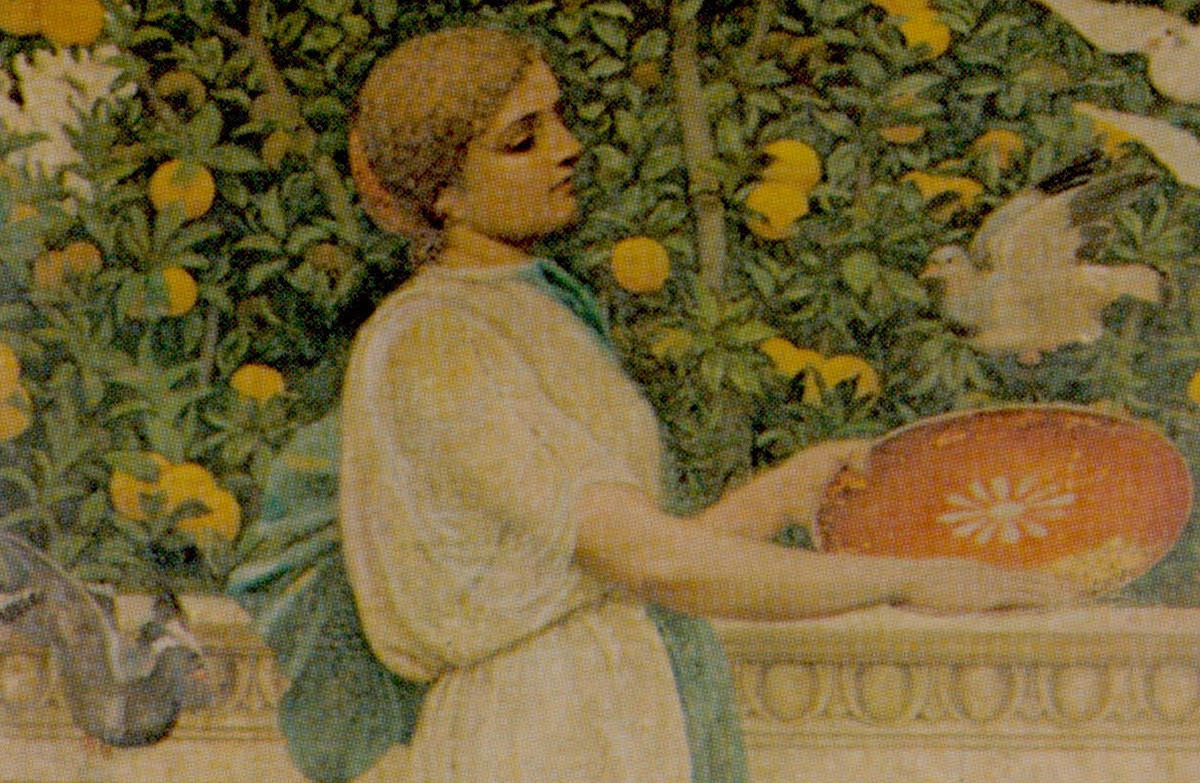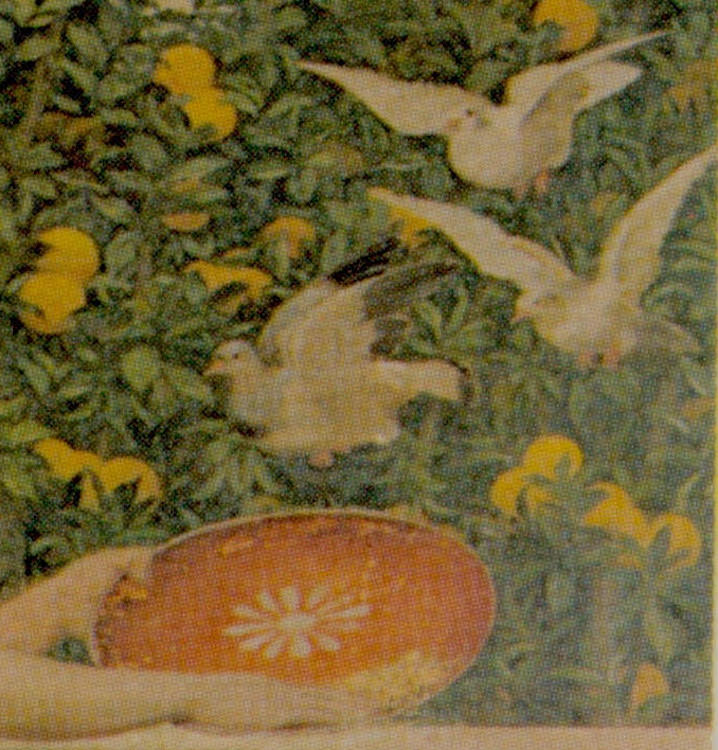
L. M. Lamont in his book about Thomas Armstrong, A Memoir discusses this major decorative project, explaining that the artist, when he came back to England in 1873,
was engaged upon work, which particularly peculiarly fitted his tastes, in which he was associated with his friend William Eden Nesfield (1835-1888). The latter had received a commission from Mr. Henry Renshaw to remodel Bank Hall, near Chapel-on-le-Frith, Derbyshire, and Nesfield suggested the decorative panels for the dining room should be entrusted to Armstrong. He, in his turn, collaborated with Randolph Caldecott, who painted all the birds which formed a feature of the decoration. It was his first work in oils…Before the work was fixed in its place it was exhibited at Deschamps' Gallery in New Bond Street, framed in its oak mouldings, and attracted much attention" [35-36]
The paintings were finally installed in the house in 1875.
Henry Constantine Renshaw was a Salford flax spinner merchant who had bought the Bank Hall estate in 1864 and lived there until his death in 1894. He had the house largely realtered in 1872-74, including adding the new dining room. Nesfield, the architect, had been in partnership with Richard Norman Shaw from 1866-69 although they never designed a joint work. Nesfield and Shaw had become friends when they were articled to the architect William Burn. Nesfield was friends with other artists besides Armstrong and Caldecott, including James Whistler, Albert Moore and Simeon Solomon. Armstrong had met the younger Caldecott, his fellow Manchester-born artist, in May 1871 and the two quickly formed a close friendship that was to last until Caldecott's early death in 1885. Caldecott painted all the birds in the decorative scheme for Bank Hall, including two large panels, one featuring swans and the other a stork and magpie. Armstrong and Caldecott later collaborated on additional decorative schemes, including one at Broome Hall, Holmwood, Surrey in 1875-76.
I. The Goldfish Bowl

Oil on canvas; 69 x 95 inches (175 x 242 cm). Private collection.
The Goldfish Bowl was the large central panel and featured a woman in classical garb kneeling down moving goldfish from a marble pool into a large glass goldfish bowl. A young girl, also in a classical gown, stands to the right with her right arm resting on the marble ledge of a wall upon which a male youth in a red cap reclines. A grove of orange trees can be seen in the background through which only a glimpse of sky can be seen. Bulrushes grow in the marble pond while orange lilies are growing to the left of the kneeling woman by her right foot.
II. Feeding Pigeons
.

Oil on canvas; 68 x 47½ inches (172.7 x 120.7 cm). Private collection.
Two details:


In the left hand panel Feeding Pigeons a classical maiden stands upright holding a plate with the grain she is feeing to the pigeons, some of which has fallen to the ground close to her feet. Caldecott painted the pigeons. She is standing next to the same marble wall seen in The Goldfish Bowl, with the same orchard of orange trees in the background and orange lillies again growing at the base of the wall.
III. Girl with an Embroidery Frame

Oil on canvas; 68 x 47½ inches (172.7 x 120.7 cm). Private collection.
The third panel situated to the right in the decorative scheme was A Girl Holding an Embroidery Frame. It features a girl in classical garb seated and holding an upright embroidery frame in her right hand. She appears to be embroidering flowers, including orange lilies. A white cat lounges to the left of her feet. This panel gives an extended view of the background, showing another marble wall in the midground, and distant green hills in the far distance with a sky filled with clouds. Small studies in gouache on card for these three panels are in the collection of the Victoria and Albert Museum, London (accession nos. P.4-1969, P.5-1969, P.6-1969). These show that Armstrong modified details significantly in his final compositions from his initial ideas, although the general format for the most part remained the same. Modifications are the most marked in the panel of A Girl Holding an Embroidery Frame where in the preliminary study another girl kneels at the feet of the girl embroidering who, in turn, is seated much higher in the composition in an entirely different pose and with the background completely changed. The final composition Armstrong chose to paint is much more effective than the study.
In 1877 Armstrong exhibited Feeding Pigeons at the Royal Academy, no. 301, and A Girl Holding an Embroidery Frame at the Grosvenor Gallery, no. 67. These are likely variant versions of the paintings Armstrong did for Bank Hall. The critic of The Art Journal praised the colour of Feeding Pigeons: "T. Armstrong's picture of a girl in a brick-red dress of classic design Feeding Pigeons (301), is sound in drawing and quiet yet effective in colour" (246). Another critic described it as "more careful and refined in treatment than most of its surroundings" (Boyes 272). This suggests at the least that Armstrong has adopted a different colour scheme for the girl's classical gown. A reviewer for The Builder preferred Armstrong's contributions at the Grosvenor Gallery to Walter Crane's The Renascence of Venus; "We must pass over with a word three small works by Mr. Armstrong, which do not represent the best that he can do, though there is artistic quality in his Girl holding an Embroidery Frame , of a much higher order than in Mr. Crane's quasi-modern Venus" (440). The reviewer for The Architect was even less impressed, stating: A Girl Holding an Embroidery Frame (67) is poor and affected enough" (319).
Bibliography
Boyes, J. F. "Chiefs of our National Museums. No. V. – The South Kensington Museum. Mr. Thomas Armstrong." The Art Journal (1891): 271-73.
"The Grosvenor Gallery." The Builder XXXV (May 5, 1877): 439-40.
"The Grosvenor Gallery. –II." The Architect XVII (May 19, 1877): 319-320.
"Highly Important Victorian Paintings & Drawings." London: Sotheby's Belgravia (October 6, 1980): lot 65.
Lamont, L. M. Thomas Armstrong, C.B. A Memoir. London: Martin Secker, 1912,
"The Royal Academy Exhibition." The Art Journal New Series XVI (1877): 245-47.
Created 19 March 2023